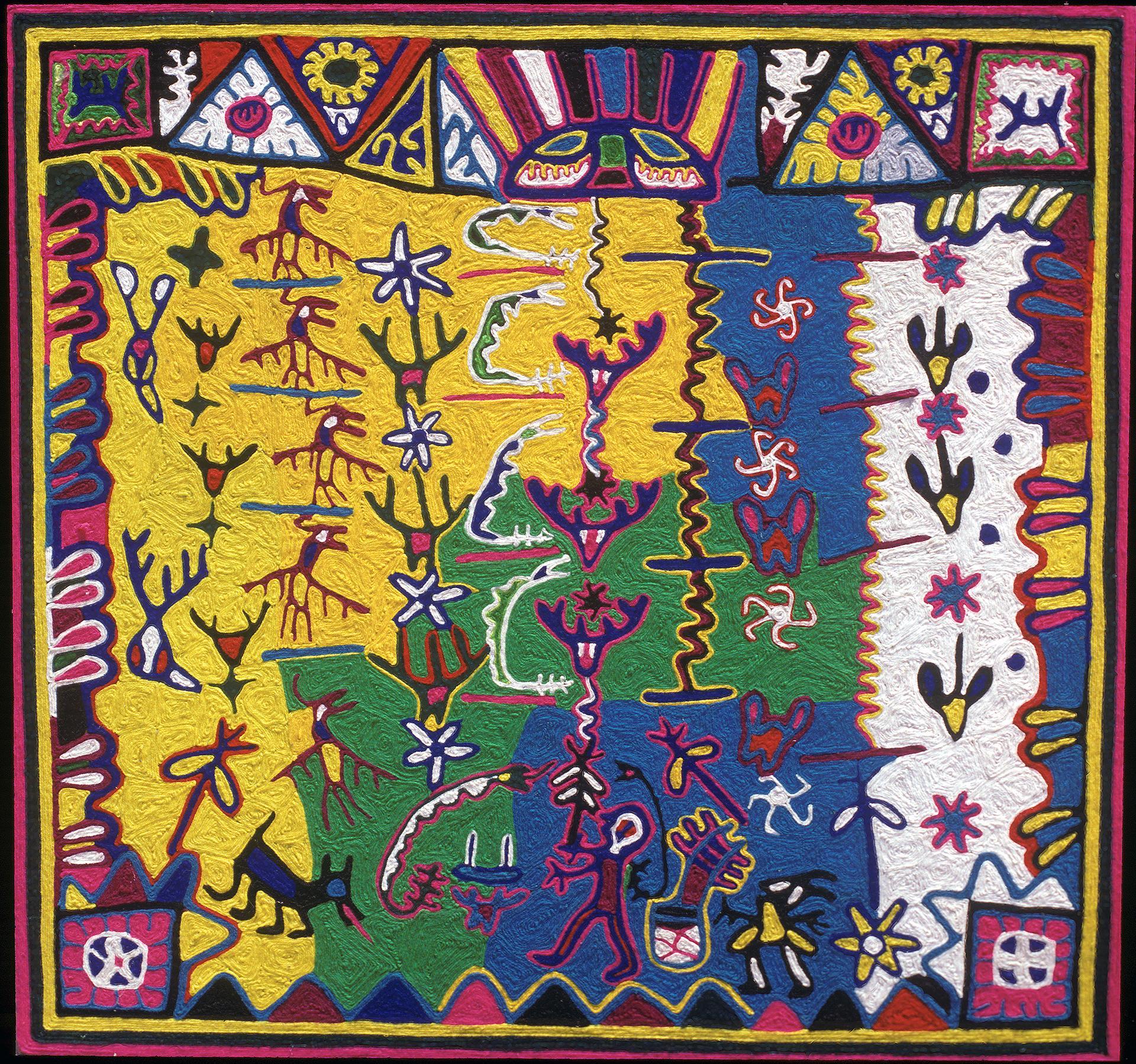The Capture of the Sacred Crystals / ‘Imarika memikahekikia mematiwiyarie

This is a representation of Wirikuta, the land where the consumed peyote is transformed into nierikate and permits the mara'akame to see the words and aspects of Our Ancestors. Tawewiekame, Our Sun Creator (center top Center), emerges for the first time over Reu'unaxi, the Burnt Peak. In their temples, located over the sacred hills, waparieya mamakáme (triangles at top and squares in the corners), the Tsauxirikame (mara'akame or advanced shaman that appears in the lower central part of the painting) can capture the teiwarixi, quartz crystals that incarnate the spirits of some wise people, the dead and ancestors (black figures along the central line). He is assisted in this by his sacred allies, Our Elder Brothers the Deer. He is also aided by his wife and his nierika, represented here as a flower with yellow petals. The snakes, one behind the tsauxirikame, haiku (cloud serpent), and another before him, xainiu (rattlesnake), aid him to hunt the deer as does his black dog. The mara'akame's chair is suspended in space, in front of his wife. Before him, on a takwatsi, shaman's basket, he has placed two candles, and below, a deer's head that symbolizes Tamatsí Kauyumarie, Our Elder Brother Fawn of the Sun, who acts as the intermediary of the mara'akame. With his muwieri, feathered arrow, the mara'akame attracts the divine crystals of Tawewiekame to this other celestial body in stages, 'imumuitsi, stairs to the skies (his steps are represented with horizontal lines).
Tawewiekame, here as the sun, is held over the shoulders of his Elder Brother Deer who lend the nierika to the mara'akame. From right to left we see Xexeurawete, with one central horn (white background); Kuatemukate, whose red antlers are like buttons with nierikate (white forms with extensions that can spin); Wawatsarite, deers with large antlers (central column) that have black crystals in between them; Nunuitsikate, deer with a pair of antlers at each side and nierikate with white petals in between; Werikaxi, royal eagles; ‘Utsikiukate(fawns to the left, traced in black with red heads); and, finally two witse, hawks that descend with the crystals (far left) to the place where the ma'arakame placed his votive feathered arrow (lower left).
Through the peyote's mirrors (circles at top border), the nierikate, the mara'akame can see the ancestors transform into their permanent form (be that a special rock or another eminent force) like Kakaiyarixi and Takauyaxi. They present themselves to the mara'akame, like the dead who return as crystals, teiwarixi, humans who have left their memory to their extended family. One of the crystals descends directly from the sun as a rock, téka, toward the plumed wand of the mara'akame. The margins of the painting are decorated with feathers that transmit the words of Our Ancestors. The colored triangles along the lower border are the sacred peaks of Wirikuta.
Wixarika translation by Tutupika Carrillo (2019):
‘Iki Wirikuta kemiti’ane nihikitini, hikuri kwieyaritsié mana mitihekiata nai, mara‘akame mipitia miniereni kemitikuniuwa kakaiyarixi wahetsie mieme. Takaiye tau (hixiapa maka) matiari mireu’unaxi matiné. Yuteyupani memuku‘uitiatiká kememite‘uitiarietiká terita yemuritsié (hautamitsiti mihekia ‘ikiya muti‘axetsié, nierika ‘ikitetsié), tsaurixika (‘ena ‘ikiya hixiapa mika‘axetsié) teiwarixi puwatiwiyawe, teka miyiyiwi memite‘uyemate wa‘iyaritsié mikahake, memeutakwixia yatini tatutsima (‘ikiya yiyiwiti matéi hixiapa). Wewiekate mepiparewie, tamatsima maxatsi. Hepaina ‘iyaya nierikaya memiparewie, ‘ikitsié tuutú tataxawiti xawari yeyeuti. Kuterixi, xewiti tsaurixika warie haiku makuka, xewiti ta hixiena muka, ku xaye, memiparewie maxatsi muwataweiyatsié, ya xeikiá tsikiya meuyiwi kemitiuweweiya. Mara‘akame ‘iparieya wapai puyewié, yu‘iya hixie. Hixiena takwatsitsié, miki hutame katira niti‘uitiani, hetiana maxa mu‘uya tamatsi kauyumarie yuxatati, mara‘akame tixaxatameya. Mara‘akame tetexi matikirietiyeika yumuwieriki, mara‘akame tawewiekate watetexi matikitiyeika, xiripa kwi meyeika, ‘imumuitsi muyuawitsiepai.
Tawewiekame yumatsima wanaiparitsiepai pakuka, miki nierikaya memuyetia mara‘akametsia. Tserieta ‘utata Xexeurawete mepuyuhekiá, xeime ha‘awati hixiapa (mayetuxá); Kwatemukate, ‘awateya mixetá putuni paimitiyuhekiá (‘ikiya tuxati ta‘aurié maxiriwenipai mitiyuhekiá); Wawatsarite, maxa‘awate papati (mukahé hixiata) tetexi yiyiwime mexeiya hixiapa; Nunuitsikate, maxatsi hutame me‘u‘awati, nierika xawari tuxatihixiapa; Werikaxi; maxatsi temari ‘utata (me‘utiarietikaiti yiwimeki memu‘ú xetame); ‘imatirieka ri meyuhutatikwixutsi ‘emeneneti tetexi memanakaxiriwa (tetsiena ‘utata) manatsié mara‘akame miretipí ‘irite muwieri ‘akawiti(hetianatsié ‘utata).
Hikuri xikirieyatsié (xikirawiti tetsiena heimá) tateteima tatutsima mara‘akame piwaxeiya tawewiekate tetexitsié, mara‘akame hixie mekaniti‘uweni mikite memanunuwaniki, teiteri yu‘iyari yatini memute‘uyemaikái yu‘iwamarixi memitewaruku’erixi. Xewiti teté tautsié miyenuiwaxi, mara‘akame ‘itsí ya muwieriki niti, nierikatetsié, memeniitiatiki muwieriki, tawewiekate waniuki muwierite muniuka.




